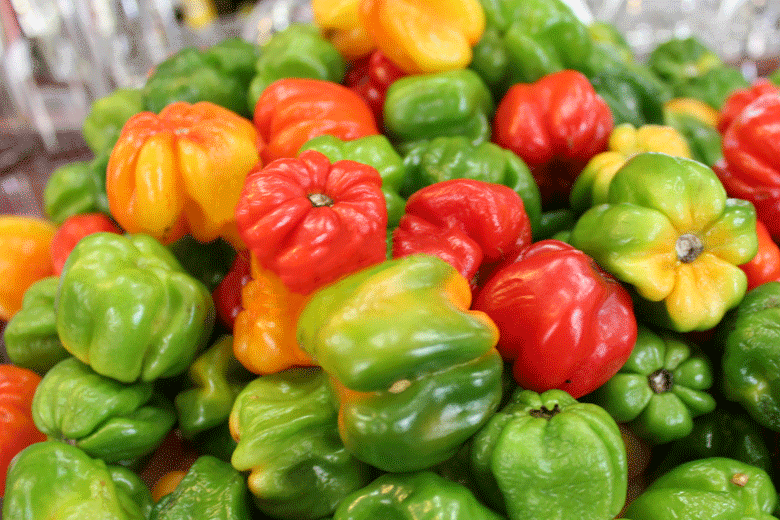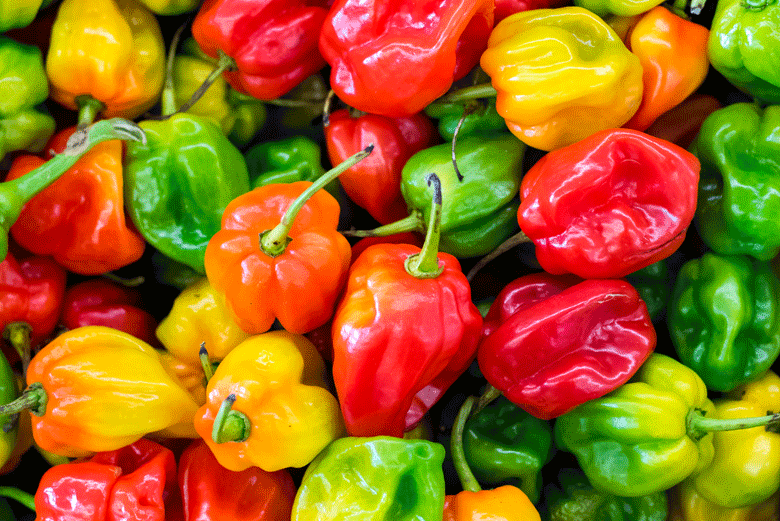Will the real Scotch bonnet stand up?
Scotch bonnets and Habaneros are closely related. They are both from the same species and may even share the same origin. It is believed that the Taino people from South America originally brought similar Chillies to the Caribbean when they travelled there many thousands of years ago. The Habanero travelled a different route to Mexico. They may have been brought there by birds or also by Amerindians from the Amazon. Birds eat Chillies and distribute seeds in their droppings when they migrate. When considering the Yucatán Peninsula in Mexico’s proximity to Cuba, the bird theory is plausible. Cuba is after all in the Caribbean and was one of the countries the Taino settled in.
droppings when they migrate. When considering the Yucatán Peninsula in Mexico’s proximity to Cuba, the bird theory is plausible. Cuba is after all in the Caribbean and was one of the countries the Taino settled in.
We all know that Habaneros and Scotch bonnets often get confused. All you need to do is search the web, and you will get many conflicting views. Some have the Scotch bonnet as looking like a Tam o Shanter cap or like a cup with a saucer. Others have Scotch bonnets squatter with lobes and resembling a small pumpkin. Yet others are squashed with no lobes at all. In some images, it is even possible they may even resemble a Habanero
Habaneros are often described as lantern shaped with a rounded top that tapers to a point. However, once again, if you surf the web, you find images of Habaneros in other shapes. Some squashed with distorted lobes, some teardrop shaped and others stunted. It can all get a bit confusing.
So, what is the truth of the matter? Let’s dig deeper to sift the wheat from the chaff
So, let’s start with Habaneros

Are all Habaneros the same?
Most people imagine a Habanero to have a certain look and colour. In the case of common Habaneros, like the orange Habanero, this appearance is conical, or lantern shaped with folds and indentations. Other Habaneros with a similar shape can be found in various other colours, including red and yellow.
Fair enough, these are the types of Habaneros that might be encountered in everyday cooking, but are they the shape of Habaneros as a general rule? The long and short answer is no. There are in fact many varieties of Habanero. They can be found in various shapes, sizes, and flavours.
These include Habaneros that are mild in flavour with low Scoville heat ratings, like the Trinidad green with a SHU of 3000 SHU, and the Zavory Habanero that clocks in at a mere 100 Scoville heat units. The Trinidad green’s shape is elongated, oval and sharply tapered. It has a distinctly gnarled / dimpled appearance. As the name implies, this Chilli is green (pale green to be precise).
The Zavory, on the other hand, only grows to 50cm when fully grown. It is red when ripe. It too has an oval shape, but with a more rounded tip. Its shape is slightly rectangular with less indentations and creases than the Trinidad Green.
On the other end of the scale, you get superhot Habaneros like the Dorset Zinger. This Habanero has tested to rate at 1060000 SHU. Its shape can be described as conical with a pinched waist. Some pods even resemble an ice cream, come with a scoop of ice cream on top. Its skin is smooth, but has small pimples scattered across it
And that’s not even counting the ones in between, like Red Savinas, Datils, Maya red Habaneros, orange Habaneros and Hainan Yellow lanterns. These are habaneros that range from 100000 to just under 600000 SHU.
What do Scotch bonnets look like?

Getting to the root of the matter
By most standards, the classical Scotch bonnet shape resembles the “Tam o Shanter” cap. When you look at this hat, it has a top with pleats and a pom-pom. Many English-speaking people, me included, would think of a bonnet as old-fashioned headwear commonly worn by ladies in the past. However, in Scotland, there are what is referred to as men’s bonnets. The “Tam O Shanter” is a bonnet or cap worn in Scotland. The Chilli was given its name because of its resemblance to this hat
However, when you go onto some cooking programmes on YouTube or similar, the pictures shown of Scotch bonnets typically used in cooking don’t seem to look anything like it. That raises the question. What on earth is the real Scotch bonnet. Is there a way to define its shape, taste etc?
cooking don’t seem to look anything like it. That raises the question. What on earth is the real Scotch bonnet. Is there a way to define its shape, taste etc?
According to Jean Andrews in her book, the Pepper Trail, the classical Scotch bonnet looks like the one fitting the Tam o Shanter description. She says the stem end is depressed. It’s always rounded top end folds into a crimped outer wall just below the base of the Chilli. That sounds like the Scotch bonnet referred to above
On the other hand, the ministry of agriculture of Jamaica has a classification system for Scotch bonnets. At the top end of the scale, a Chili was specifically selected to personify what a classical Scotch bonnet should look like in terms of shape, size, colour, and taste.
The MOA Scotch Bonnet has three grades. The best grade should have a cup and saucer shape with three to four well shaped lobes, be not less tan 4,5 cm in diameter and have a uniform colour typical of the variety. The second and third grades are far less stringent in their requirements, with the lowest grade not even requiring the lobes to be distinct. It doesn’t necessarily even have to have the distinctive cup and saucer shape of the classical Scotch bonnet.
Conclusion.
So, Scotch bonnets come in various shapes and sizes. There are also many varieties of Scotch bonnets, including the Faria, Burkina Yellow, Scotch Bonnet chocolate, Scotch Bonnet sweet, Tobago orange Scotch bonnets and many more.
While Scotch bonnets are more commonly recognized in their classical Tam o Shanter shape, they can also be found in other shapes. It all boils down to what grade of Scotch bonnet it is and whether it is a pure strain of Scotch Bonnet. At the lower end of the scale, in terms of MOA grading, a Scotch bonnet can even resemble a Habanero.
Not that the shape makes any difference to the taste though. Scotch bonnets are simply the best
Reference: Jean Andrews, The Pepper Trail, 1999, ISBN I-57441-070-9
Image credit
Photo by David J. Stang / CC BY-SA 4.0 / via Wikimedia Commons

